Macaron tips
Today I have some more macaron tips for you! I want to talk about the three main stages you have to master in order to bake perfect macarons. Regardless of the recipe and method you are using, as long as you master these three stages, you will be in pretty good shape!
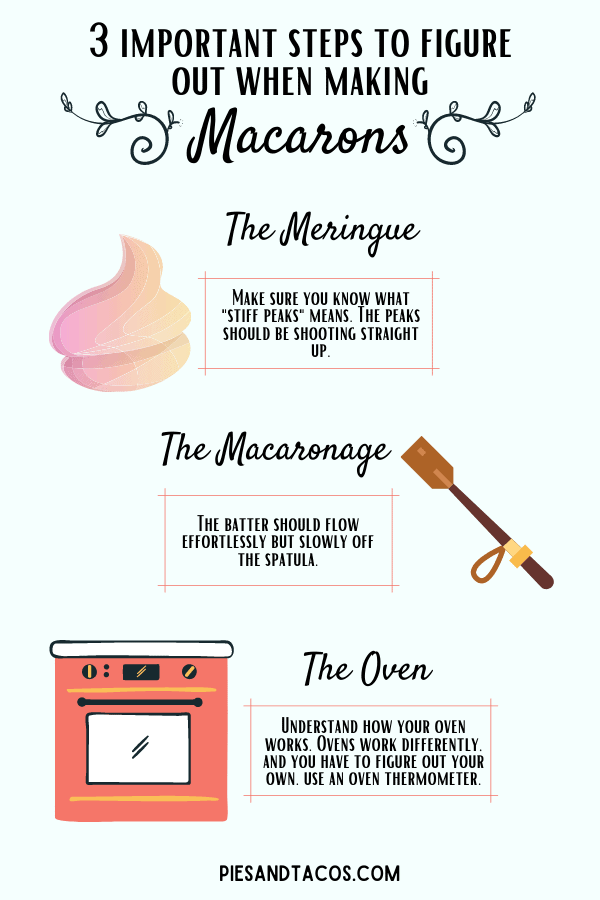
Three main stages to learn
The three main stages to learn and master are: the meringue, the macaronage, and the oven! And in the following post, you will find many macaron tips and knowledge on how to master these stages.
On my previous post How to Make Perfect Macarons, I’ve outlined 5 basic macaron tips, and the first one was: find a recipe and method you like the most, and work on perfecting it.
This post may contain affiliate links. I earn a commission from qualified purchases. Please read our Privacy policy here.
So, once you find a recipe and method you are willing to work on and use to perfect your technique, it’s time to pay attention to three main areas: the meringue, the macaronage, and the oven.
And regardless of what method or recipe you are using, the macaron tips below will for sure be helpful to you.
Let’s dive in!
The meringue
Learn how to make the most perfect meringue, with stiff peaks, not over whipped, and not under whipped, but just right. And how do you do that? Well, you practice.
The meringue should have peaks that are shooting straight up. Not bent down to the side, and not soft and long. The peaks should be somewhat short, or medium height, and be shooting straight up, with maybe a slight bend at the top, without bending down, but something like a slight curve.
The following video is a good example of what the meringue should look like. Click play and it will show you the exact time where I show the stiff meringue.
By the way, I have lots of videos on my Youtube channel showing you how to make macarons! Check them out here!
Here are some common meringue issues:
Under whipped meringue will cause cracked macarons with no feet, macarons that spread out because the batter is too wet and runny, hollow macarons.
Over whipped meringue will cause hollow macarons, feet that are too tall, stiff batter that can be too hard to fold sometimes and won’t achieve the perfect consistency.
Broken meringue (due to water drops, or grease particles touching the meringue, or over whipping) will cause cracked shells, no feet, or porous looking shells.
Check out the Troubleshooting post here.
This right here is what your meringue is supposed to look like.
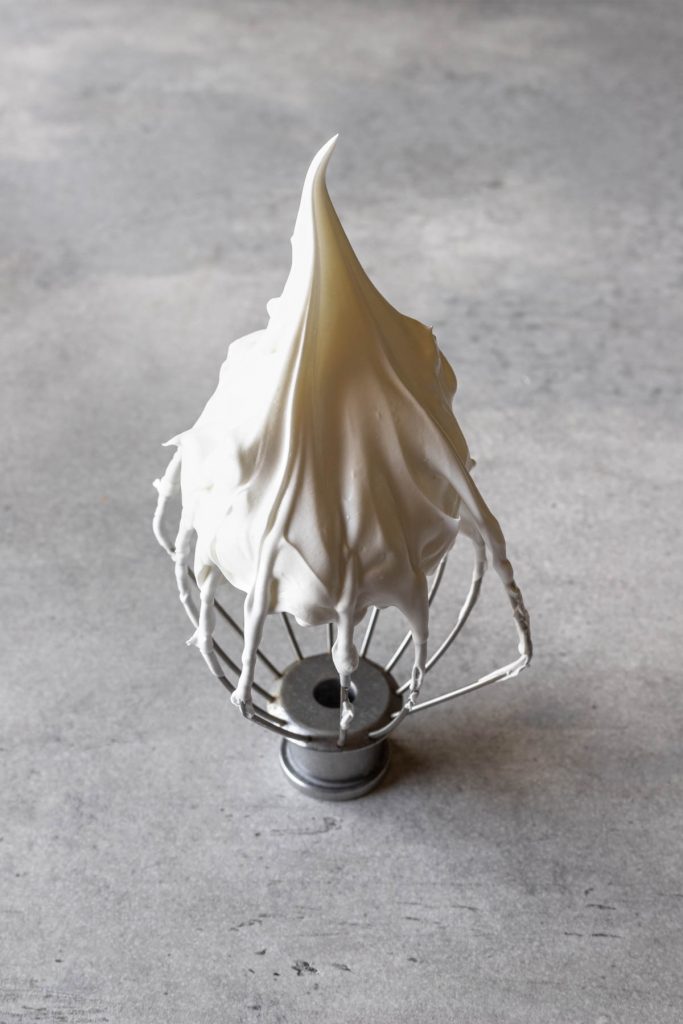
The macaronage
Let’s talk about the macaronage. When to stop folding macaron batter?
I’ll say this: it’s always best to under fold the batter, then to fold it too much. Because once you pipe your first macaron and realize the batter hasn’t been folded enough, you can easily just fold it a couple more times and get back to piping.
If you pipe your first shell and realize the batter has been folded too much, there’s nothing that can be done to fix that.
Under folded batter will have a pointy tip at the top of the shell that won’t smooth out as you bang the trays or wait it out.
Over folded batter will spread out too much, and maybe the feet will spread out as the macarons bake, the macarons might crack, and they might be misshapen, which means not a perfect circle.
Also, it’s good to notice that if you fold the batter too much, but not to the point of causing the feet to explode to the sides, or the shells to crack and be misshapen, this causes another very common issue: hollow macarons.
And lots of times, when macaron bakers are having a hard time pin pointing why their shells are hollow, since they are doing everything perfectly, it can be due to over folding the batter ever so slightly.
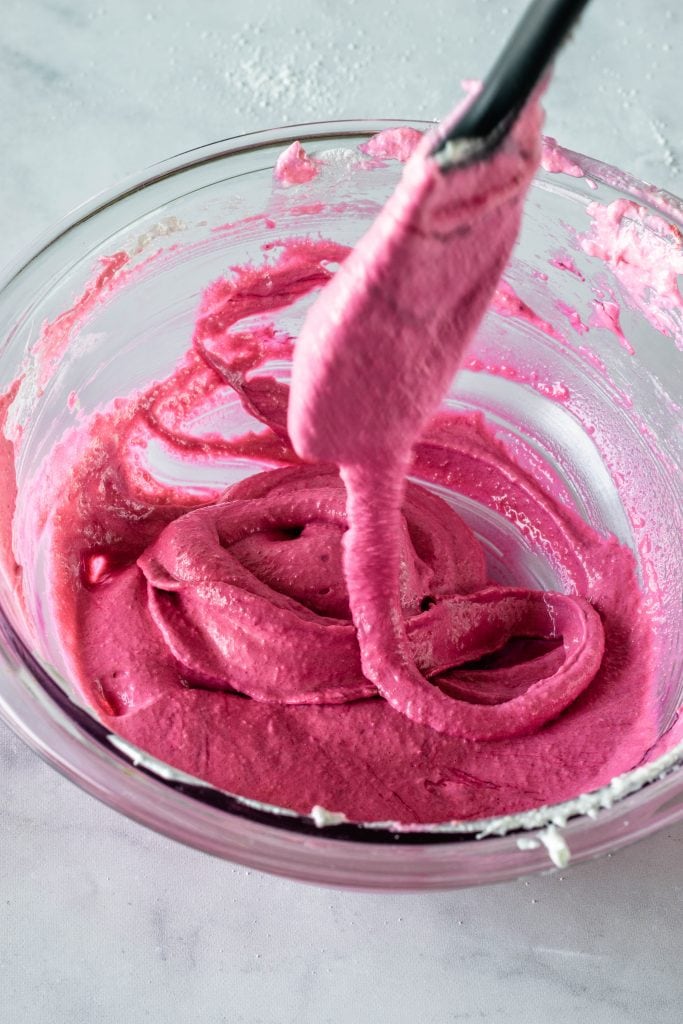
Watch the following clip showing you what the batter is supposed to look like. Just click play and it will be at the exact time of the video where I am showing the macaronage:
For the macaronage to be perfect, you are supposed to be able to draw a few figure-8s with the batter flowing off the spatula without the batter breaking up.
The batter should fall slowly but effortlessly off the spatula, without breaking up too soon, or too often. And if it does break up, it should continue to flow after that.
If you are a beginner, perform something I call the Teaspoon test. Grab a teaspoon of batter and spoon on top of the silicon mat or parchment paper. Give it a minute or so, as you tap the tray gently against the counter.
If the batter is still forming a tip at the top that won’t smooth out or spread out, it means you can fold it a couple more times.
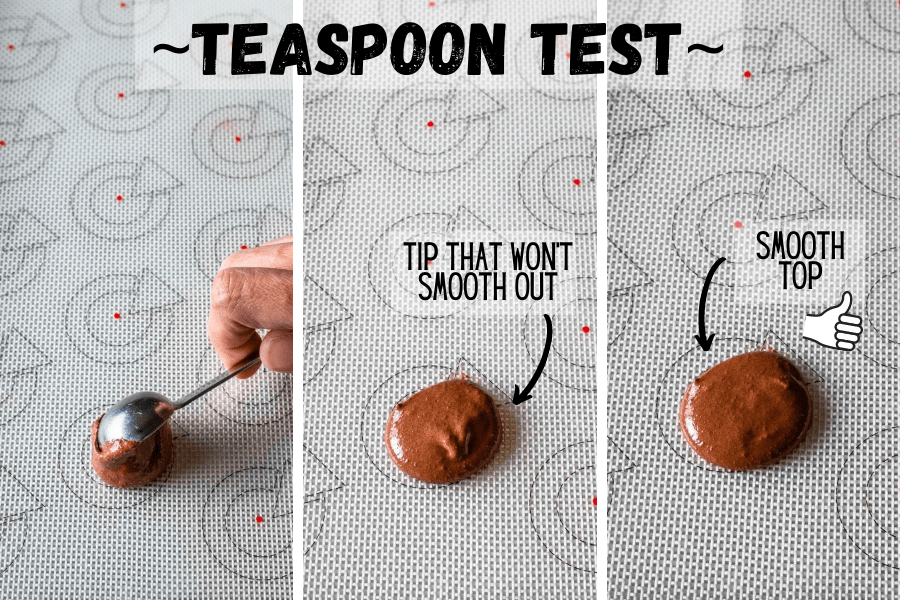
The oven
Now this is a very important one. Possibly the most important factor. Because you can have done everything right up to before baking the macarons. And then when it comes time to bake them, the oven can totally make or break the whole deal.
Take time to learn your own oven!
Your oven is most likely different than mine, which is different than your neighbor’s oven, and your mom’s, and your friend’s.
So probably one of the best macaron tips I can give you is: make sure to have an oven thermometer. This should probably be on top of every single macaron post I make, because it’s THAT important.
It’s absolutely necessary to have an oven thermometer when making macarons. They are inexpensive and essential.
Why is it so important to have an oven thermometer?
Home ovens are almost always inaccurate. The oven’s internal thermometer is gauging the temperature of where it’s installed, which is on a spot in the back or sides of the oven, where it’s subjected to drafts or hot spots, so it’s not actually telling the temperature of the inside of the oven, where the macarons are baking.
Plus, ovens cycle on and off in order to keep a stable temperature.
So all of these things just mean that the temperature you are setting your oven to, probably won’t be consistent or reliable. The only way to really know and be able to control the oven temperature is to have an oven thermometer in place.
Macarons are very finicky and delicate cookies, and a simple 5 degree difference in the temperature can yield extremely contrasting results.
Here’s the perfect example. The two shells above are from the exact same batch (they are regular non-vegan macarons, but the same applies). The shells on the left were baked at 320ºF and the shells on the right were baked at 325ºF. Look what a 5 degree difference can do to the shells.

This is why you should take time to learn your oven!
Pipe the macaron batter between different sheets, and bake each at one temperature. Also experiment with the height of the oven rack. Make notes about the results.
Also, keep the notes and experiment with different batches also, since there could be issues with other factors in the batches that could influence the results.
High oven temperature can cause: feet to spread out, macarons to crack, hollow macarons.
Low oven temperature can cause: macarons with no feet, macarons that won’t form a bottom skin, hollow macarons.
And yes, hollow macarons can happen if the temperature is too high, or if the temperature is too low. Which may seem weird at first, but once you’ve been baking macarons for a while, you know nothing is weird when it comes to understanding these little cookies!
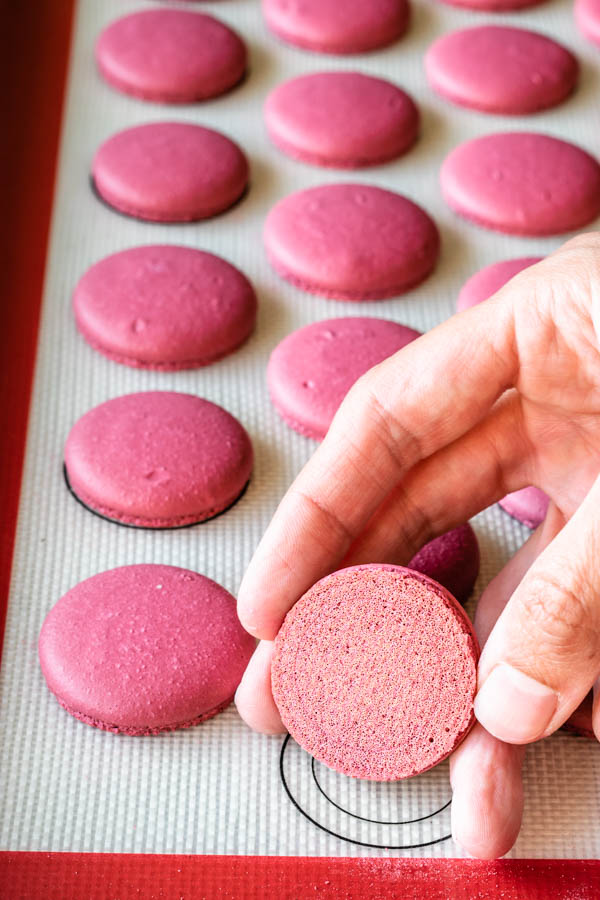
Finding the optimal temperature for your oven, your method, your climate is the best move here!
Also, somethings to consider:
- If you are using a convection oven, drop the temperature by 10%, or something like 25 to 30 degrees Fahrenheit.
- If using a dark baking sheet, drop the oven temperature (or consider buying a light colored baking sheet, like a silver one). Dark baking sheets tend to retain more heat.
- Italian method will usually require a slightly lower oven temperature.
- Consider looking for hot spots in your oven, I have three oven thermometers in my oven, and I know that my front left corner gets hotter than the rest of my oven.
While baking the macarons, I usually rotate my trays every 5 minutes or so, because my oven is not very even, and doesn’t keep a good constant temperature all throughout.
Some bakers don’t have to do that, since their oven is great at keeping the temperature constant on all four corners.
Find out what works best for your own situation.
Anyway, I hope you enjoyed today’s post and tips!
Visit Macaron School to see more informative posts about macarons.
Here are some posts that might interest you:
- How to make perfect macarons
- Frequently asked questions
- Understanding your oven
- Macarons for beginners
- Macaron Troubleshooting Guide
- Tools I use to make macarons
- Vegan Macaron Troubleshooting
- Meringue lesson
- Hollow macarons
And for my whole list of macaron flavors please click here.
Also visit my YouTube channel, where I post macaron videos every week!
Click here to pin this image for later.





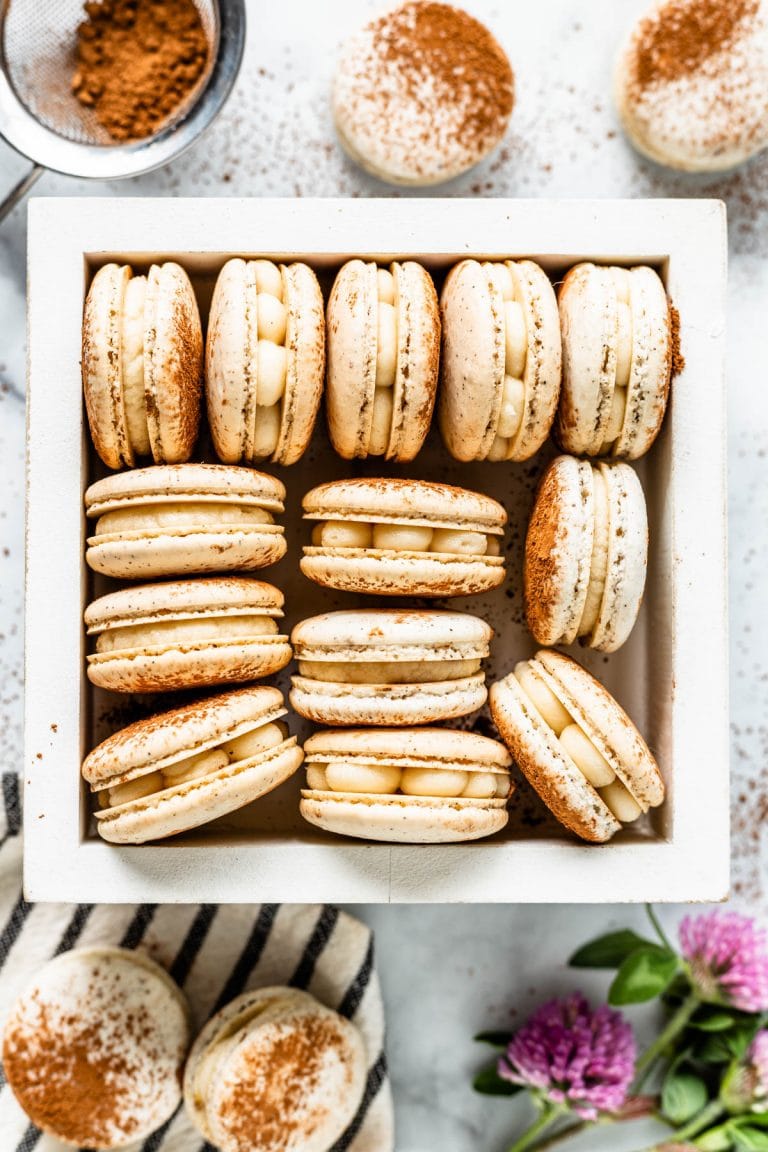


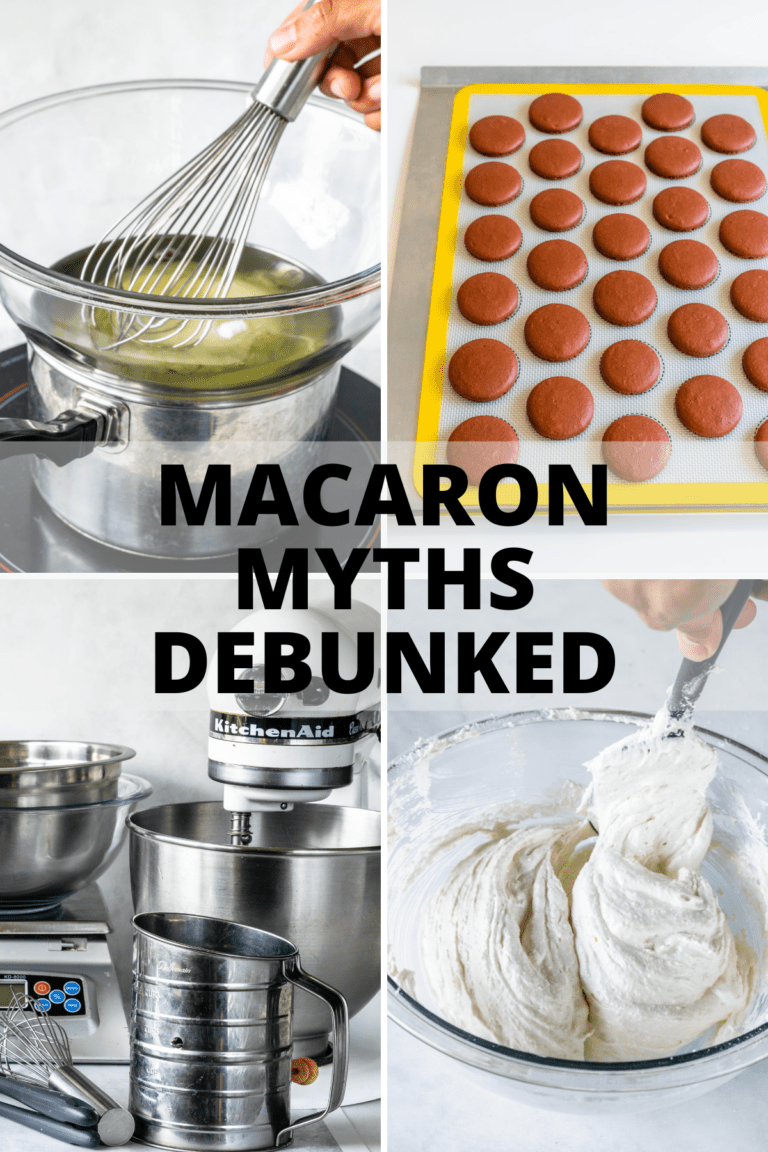

What a great post! One of the best posts: Very informative, very clear and very detailed with great photos. Thank you so much!
Thank you so much! I will be making more soon! 🙂
Excelentes dicas, obrigado por compartilhar!!!!
Obrigada!! 🙂
Thank you for your tips, they help a lot. I love your blog.You’ve made amazing macarons !
I am so happy you find them helpful!!! Thank you!
Thank you so much for your tips and flavour combinations. I’m still finding the Italian method the best one for me.
good tips! amazing!!! i love it! i been practicing, still fighting with my oven temperature, i’m wondering if i have to age the whites before using them in the swiss method…hmmm.. can’t wait to keep trying! hehehe
I dont age my egg whites, I have tried aging them and not aging them and don’t find any difference! Thank you I am happy you enjoyed the post!
I feel like heading straight into the kitchen, turning my oven on and having a go at making some macarons! Thank you so much for all your wonderful tips, I have definitely learned a lot just from this one blog post. Much appreciated!
Thank you so much Katerina!
These are all very useful tips especially for those who doesn’t make macaron often like me. The collection that you have with a variety of flavors is to fill the eyes.
Thank you so much Denise!!!
Tried making the chocolate macarons following your recipe and succeeded my first try at macarons. Probably a fluke because I never succeeded again! My oven temp drops a lot when I open it, it’s slow to heat, plus it has hot spots (I know this because on my best try since that first time I had normal macarons with normal feet and cracked ones with no feet on the same tray. Turning the tray (opening the door) makes it fluctuate more. Just a rant. Question: Can the meringue be *too* stable? Thinking of adding c. of tartar with your recipe next time.
I recommend starting to preheat the oven at the same time you start making macarons, or even before. This will help unstable ovens to keep somewhat of a more stable temperature without fluctuating so much, the longer the pre-heating time.
Have you tried not rotating the trays?
Yup! I switched out my silicon mats for parchment and less of them crack but still quite a few. My oven is top heated only (I think. It has a convect bake option which I don’t use and a broiler coil on top without any element on the bottom) so I’m wondering if i need to double pan with the bottom pan preheated…? Use the bottom rack and increase temp…? Too much science haha. Drying wise they get completely matt and I can gently swipe the top.
So if the heat comes from the top I would move them down to the bottom rack. What temperature do you currently bake them? and do you have an oven thermometer?
Also, you can turn the convection bake option on, that would probably help distribute the heat evenly, but you’ll have to turn the temperature down by 10% of what you’re doing right now.
So I moved them to the bottom rack, baked at 305F according to an oven thermometer at the same level without convection as the fan is really quite strong (oven base mat flaps). And…yay no cracks! The feet rise way up not out but don’t quite settle so I have bigggg feet with biggg hollows! The shells spread slowly after piping and were smooth and actually on the flat side so I don’t think I undermixed..but! I’m happy enough to take a break for a few weeks haha. Whew! Thanks for your responses and your amazing blog!
Hi, your macarons look sooo good. I have made quite a few myself. I try not to open the oven so they do not collapse, so I do not rotate my trays. I try to let them dry the longest possible, because I noticed that if you don’t leave them long enough, they will crack and not rise as much.
You should try making eclairs….
Yes, if your oven distributes the temperature evenly inside no need to rotate the trays.
And yes eclairs are delicious!
I love your blog and have made so many of your recipes! My shells are often hollow. This last time I got the tops smooth with no cracks and they were also smooth on the bottom, but hollow in the middle. This last time I watched your video again and think the consistancy was right. Do you think maybe the oven temp is to high? I do have dark mats.
Love all your post. One quick question , can you recommend me a good silicone mat for macarons. I have one that has edges and I can’t get the macs to not stick. Thanks in advance for your help .
I have been using silpat and love it!!!
Love your blog with beautiful macaron, it encourage me to practise more and more. I have a problem with the feet of my macaron, there is a crack between the head and the feet, during baking time the top seems to separate from the feet, and finally it come down but the separate line still obvious. Everything else is perfect with full shell,etc. Just curious if there is any solution to this? thank you so much for all the advise on your blog
I’d play around with oven temperatures, whqt temperature are you initially baking them at?
Melhor post, Camila! Já entendi o que estou fazendo errado, agora é fazer de novo pra acertar 🙂 Eu uso o French Method…Estou errando na macaronage, under folding batter…e acho que preciso aumentar um pouquinho a temperatura do forno, mas tenho que comprar um oven termometer pra testar a temperatura real. Estou lendo suas receitas e babando, vou ter que fazer o de maracujá e o de pistache.
Obrigada Luciana!!! Boa sorte!!! Espero que de tudo certo!!! Voce consegue!!!
I have been trying to make macarons for over a year! A birthday is coming up and a present I want to make is macarons. When I macronage, should I fold hard and quickly, or more gentle and slower. When I folded gentler the macarons had air bubbles in them. So should I fold in the almond flour mix slower and do it for longer? If I do that though I’m scared I’m going to get pockets of air in them and they will crack in the oven. Please help me, I don’t want to fail again.
I am not too gentle when doing the macaronage. Just mix normally, you don’t have to beat the mixture, but also don’t be so careful with it.
And it helps to kinda spread the batter with the spatula across the sides of the bowl to help deflate the batter and eliminate air bubbles. I show it in this video: https://youtu.be/WGMH-3VrH2I?t=144 at minute 2:24.
Thank you for sharing all these valuable information! I am trying to make macarons with your recipe, but I keep failing it. I only have success with a recipe that requires a very low amount of almond flour. So after changing the cocoa powder brands for a couple of times, and adding thermometer to the oven, silicone mat, wiping everything with vinegar etc etc plus trying every evening to reach the imagined results, the macarons are still porous and with no feet whatsoever. I like your way of doing these sweets, with technically two basic recipes your macarons are so beautiful and with endless flavors, that I want to be able to make them. After so many trials and errors, my last tip is that I have to change the almond flour I use, because that might be the culprit for the poros cookielike looking “macaroni”s -as my two young boys keep calling them. 🙂
Thank you so much for your recipes and tips!! So helpful! Is it possible to make the batter ahead of time and store in the fridge until we’re ready to bake? Do we need it to be at room temperature before baking?
No, you have to bake the batter as you make it. It cannot go in the fridge